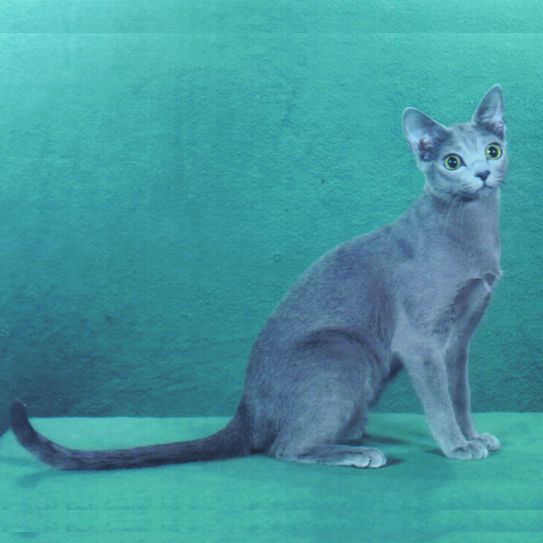 American Cat Fanciers Association
American Cat Fanciers Association
Russian Blue Breeders' Directory
~~~~~~~~~~~~~~~~~~~~~~~~~~~~~~~~~~~~~~~~~~~~~~~~~~~~~~~~~~~
The Russian Blue is a slender, dainty cat--
long, svelte and graceful.
It belongs to the group
known as “foreign type”.
This fine boning and
slenderness is shared with few other breeds.
The Russians appear to be
heavier in stature due to their double coats. It is a medium-sized cat
with the body of a swimmer rather than a wrestler.
The double coat sets the Russian Blue apart
from the other blue cats.
This is a coat made of very
dense short hair that stands out from the body at a 45 degree angle.
Each guard hair is tipped
in silver, giving the cat a very shimmering appearance.
The texture of the coat
should feel like a silk scarf in your hands –soft and luxurious.
It should be dense enough
to leave your fingerprints in the coat. Lighter shades of blue (gray)
are preferred in the show ring. There should be no tabby marks or
stripes in an adult coat.
Kittens may have faint
rings on the tail.
Another feature of the breed is eye color.
The eye color is a
brilliant green that can range from apple-green to deep jade, almost a
blue-green.
Brilliant emerald green is
preferred in the show ring.
No yellow is allowed in the
eyes of adults.
The eye shape is almost
round, just oval enough to show an oriental slant.
Eyes are set one eye width
or more apart.
The Russian Blue has a high fore-head, with
the top of skull flat and narrow, smoothly curving into the back of the
neck. The face is broad at eye level and looks even broader due to thick
fur at side of head.
The medium-length, straight
nose looks upturned from almost any view except profile due to light
reflection.
The neck is long but does
not appear so in repose, due again to thick fur.
There are seven planes on
the head – each counted separately, giving an almost serpent-like
profile when the ears are held down.
The ears are rather large and wide at the
base, tall, and set far apart, as much into the side as the top of head.
Ears look pointed, as hair
tufts finish off where the slightly rounded tips stop.
Inside furnishings cover
approximately one-half of the otherwise bare, translucent ear area. The
outside of the ears are completely covered with short, fine hair.
There should be no doming
(roundness of skull) between the ears.
Temperament
The Russian Blue
is a gentle, sometimes shy cat with an often playful manner.
It is quick to learn and has some dog-like characteristics,
like retrieving wads of paper or soft balls.
Its voice, if any, is soft and sweet, often making them a
good choice for apartment dwellers or older people.
Many, however, will talk to their owners if they are
encouraged to do so. The Russians also make wonderful companions for
children and if not handled roughly they interact easily with the
little ones. They
prefer gentle but firm handling and can at times be easily startled.
The Russian is an intelligent cat and training should be by
repetition, not man-handling.
They are often known to play Hide and Seek with their owners and to
find the highest place in the house to sleep! They are a
breed that wants to be part of the family and are curious --wanting
to inspect anything or anyone that enters their world.
They are a semi-active breed but not destructive unless
bored, stressed or neglected by their owners.
Provide a sturdy scratcher, put it in a window so they can
enjoy the outside world from the safe indoors.
Don’t hide it in a corner or basement – remember they want to
be where you are and part of your family! Russian Blues take pride
in cleanliness, preferring order rather then chaos in the household.
They will let you know if you haven’t cleaned the litter box
or if you haven’t provided two boxes for both duties! Overall, they
are a healthy breed.
Seek good veterinary care, feed high quality food, and provide daily
exercise and lots of love.
As with any breed, as a pet gets older, some health issues
may arise. Watch for any
changes in your cat’s habits.
Changes in habits usually signal a potential health issue.
Most Russians will select one family member to bond with more
closely than the rest. Often that person is the one who feeds them
as they have wonderful appetites that sometimes have to be
restricted to control their weight.
This bonding relationship will be special and you will be
rewarded with many head butts from your Blue, and many moments to
cherish.
Origin
The Russian
Blue is one of the natural breeds in the cat fancy.
It is thought that the Blues came from Russia, but some say
this can only be a theory.
Many stories have been discussed but some proof has come from
both England and Russia as to their existence.
The breed has gone through various names such as Archangel,
Maltese, Foreign Blue and Russian Blue.
Evidence of Blues is also found in the Scandinavian
countries. Fur trading
and shipping may have had some bearing on their location in these
countries.
|
Phyllis Goodell
Cattery: Kit Kat Korner |
(620) 852-3385 |
Colony, KS |
RUSSIAN Blue breed chair
Jill Hoffman
Gas KS
620-365-5746
prairiehome99@cox.net